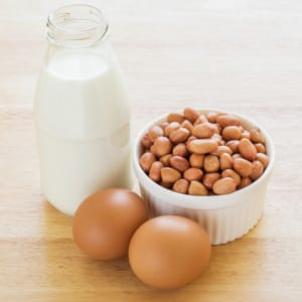
Food Allergies and the Holidays
The holidays are a common time for family and friends to gather around the dinner table. Despite the cheer and celebration, it can be a very nerve-wracking time for families who have children with food allergies. The Centers for Disease Control and Prevention (CDC) reports that 1 in every 13 children under the age of 18 has a food allergy. It is important to keep a few points in mind regarding food allergies if hosting or attending a holiday meal.
Food triggers

Johnathan Tam, MD, Allergy and Immunology Clinic at Children’s Hospital Los Angeles, states that the most common food triggers for allergic reactions in children are milk, peanuts, eggs, soy, wheat and tree nuts. Christie Bernal, RN, Allergy and Immunology Clinic, cautions that many holiday foods can contain these food allergy triggers “hidden” within the dish. Nuts are often crushed up and added to the crusts of pies, cookies or treats. Milk, eggs, soy, wheat and nuts are required in many recipes and are mixed in so well that they are invisible to the naked eye.
Preparing a meal
When preparing a meal for someone who has a food allergy, it is important to be aware of exactly what they are allergic to. Don't be afraid to ask the parents what their child cannot eat. When preparing a dish that includes the allergy trigger, be sure to use a separate preparation surface, with different utensils than the rest of the meal. Also, label the original dish so that it is not accidently eaten, causing a reaction. It is also a good idea to keep this dish out of reach of the child, especially if he or she is too young to understand that it is not safe to eat.
Attending a meal
When attending a holiday meal, it is polite to notify your hosts of your child’s allergies well in advance of the meal so that they can adjust the menu accordingly. Tell them what your child is allergic to and what reaction he or she has, and ask nicely that dishes that contain the trigger food be prepared on a separate surface with separate utensils, and to label dishes that contain the allergen. It is also a good idea to offer to prepare and bring a dish to the party that is safe for your child to eat.
Allergy signs and symptoms
CHLA’s Division of Clinical Immunology and Allergy defines mild symptoms as:
- Sneezing
- Coughing
- Runny nose
- Itchy eyes
- Difficulty breathing
- Upset stomach
- Rashes or hives
Severe symptoms are described as:
- Shortness of breath
- Wheezing
- Repetitive cough
- Pale or blue skin color
- Fainting or dizziness
- Weak pulse
- Difficulty breathing or swallowing
- Significant swelling of the mouth, lips or tongue
- Repetitive vomiting or severe diarrhea
- Sudden anxiety or confusion
- A combination of symptoms from different body areas
If your child is experiencing severe symptoms and does not have an epinephrine injection (Epi-pen), they need emergency medical intervention immediately.
Ways to Include Children with Food Allergens
- Provide a small toy to the child in lieu of the allergen containing food.
- Provide holiday craft activities for the child in lieu of a food based holiday activity.
- Offer to make the child’s favorite non-allergen dish for the meal.
- Proper supervision of child’s food intake during meal time.
- Be sensitive to the child’s allergens and try to avoid their use as much as possible.


